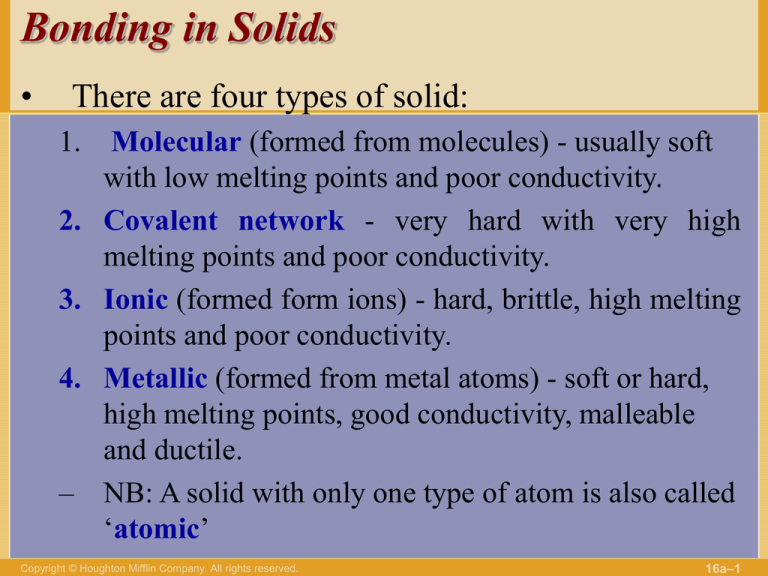
Bonding in Solids
•
There are four types of solid:
1. Molecular (formed from molecules) - usually soft
with low melting points and poor conductivity.
2. Covalent network - very hard with very high
melting points and poor conductivity.
3. Ionic (formed form ions) - hard, brittle, high melting
points and poor conductivity.
4. Metallic (formed from metal atoms) - soft or hard,
high melting points, good conductivity, malleable
and ductile.
– NB: A solid with only one type of atom is also called
‘atomic’
Copyright © Houghton Mifflin Company. All rights reserved.
16a–1
Bonding in Solids
Copyright © Houghton Mifflin Company. All rights reserved.
16a–2
Bonding in Solids
Covalent Network Solids
• Intermolecular forces: dipole-dipole, London dispersion and Hbonds.
• Atoms held together in large networks.
• Examples: diamond, graphite, quartz (SiO2), silicon carbide (SiC),
and boron nitride (BN).
• In diamond:
– each C atom has a coordination number of 4;
– each C atom is tetrahedral;
– there is a three-dimensional array of atoms.
– Diamond is hard, and has a high melting point (3550 C).
Copyright © Houghton Mifflin Company. All rights reserved.
16a–3
Bonding in Solids
Covalent Network Solids
Copyright © Houghton Mifflin Company. All rights reserved.
16a–4
Copyright © Houghton Mifflin Company. All rights reserved.
16a–5
Diamond
-Hard Structure
- Tetrahedral atomic
arrangement
What hybrid state
do you think the
carbon has?
Copyright © Houghton Mifflin Company. All rights reserved.
16a–6
Bonding in Solids
Covalent Network Solids
• In graphite
– each C atom is arranged in a planar hexagonal ring;
– layers of interconnected rings are placed on top of
each other;
– the distance between C atoms is close to benzene (1.42
Å vs. 1.395 Å in benzene);
– the distance between layers is large (3.41 Å);
– electrons move in delocalized orbitals (good
conductor).
Copyright © Houghton Mifflin Company. All rights reserved.
16a–7
Copyright © Houghton Mifflin Company. All rights reserved.
16a–8
Graphite
- Form planar sheets
- actually more stable than
diamond
What hybrid state do you
think the carbon has?
Copyright © Houghton Mifflin Company. All rights reserved.
16a–9
Fullerene-C60
•Closely Related to
Graphite Structure
•Both Six-membered and
Five-membered Rings of
Carbon are Found in the
Fullerenes
Copyright © Houghton Mifflin Company. All rights reserved.
16a–10
Artists carbon nanotubes, multiwalled
MWCNT
Copyright © Houghton Mifflin Company. All rights reserved.
16a–11
Forming Carbon Nanotubes
Copyright © Houghton Mifflin Company. All rights reserved.
16a–12
Real carbon nanotubes
Copyright © Houghton Mifflin Company. All rights reserved.
16a–13
Examples of Three Types of Crystalline Solids
Copyright © Houghton Mifflin Company. All rights reserved.
16a–14
Cubic Unit Cells
There are 7 basic crystal systems, but we are
only concerned with CUBIC.
All sides
equal length
All angles
are 90 degrees
Copyright © Houghton Mifflin Company. All rights reserved.
16a–15
Copyright © Houghton Mifflin Company. All rights reserved.
16a–16
Copyright © Houghton Mifflin Company. All rights reserved.
16a–17
X-rays scattered from two different
atoms may reinforce (constructive interference) or
cancel (destructive interference) one another.
Copyright © Houghton Mifflin Company. All rights reserved.
16a–18
Figure 16.11: Reflection of X rays of
wavelength
n λ = 2 d sin θ
Copyright © Houghton Mifflin Company. All rights reserved.
16a–19
Reflection of X rays: Bragg equation
Father and son Bragg – Nobel prize 1915
Copyright © Houghton Mifflin Company. All rights reserved.
16a–20
Crystal Lattices
• Regular 3-D arrangements of equivalent LATTICE POINTS
in space.
• Lattice points define UNIT CELLS
– smallest repeating internal unit that has the symmetry
characteristic of the solid.
Copyright © Houghton Mifflin Company. All rights reserved.
16a–21
Cubic Unit Cells of Metals
Simple
cubic (SC)
1 atom/unit cell
Bodycentered
cubic (BCC)
2 atoms/unit cell
Facecentered
cubic (FCC)
4 atoms/unit cell
Copyright © Houghton Mifflin Company. All rights reserved.
16a–22
Atom Sharing
at Cube Faces and Corners
Atom shared in corner
--> 1/8 inside each unit cell
Copyright © Houghton Mifflin Company. All rights reserved.
Atom shared in face
--> 1/2 inside each unit cell
16a–23
Atoms in unit cell
1
½
¼
1/8
Copyright © Houghton Mifflin Company. All rights reserved.
16a–24
Number of Atoms per Unit Cell
Unit Cell Type
SC
BCC
FCC
Copyright © Houghton Mifflin Company. All rights reserved.
Net Number Atoms
1
2
4
16a–25
Simple Ionic Compounds
CsCl has a SC lattice of
Cs+ ions with Cl- in the
center.
1 unit cell has 1 Cl- ion
plus
(8 corners)(1/8 Cs+ per
corner)
= 1 net Cs+ ion.
Copyright © Houghton Mifflin Company. All rights reserved.
16a–26
Two Views of CsCl Unit Cell
Either arrangement leads to formula of 1 Cs+ and 1 Cl- per unit cell
Copyright © Houghton Mifflin Company. All rights reserved.
16a–27
Simple Ionic Compounds
Salts with formula
MX can have SC
structure — but
not salts with
formula MX2 or
M2X
Copyright © Houghton Mifflin Company. All rights reserved.
16a–28
Copyright © Houghton Mifflin Company. All rights reserved.
16a–29
NaCl Construction
FCC lattice of Cl- with
Na+ in holes
Copyright © Houghton Mifflin Company. All rights reserved.
Na+ in
octahedral
holes
16a–30
Your eyes “see” 14 Cl- ions and 13 Na+
ions in the figure
Ion Count for the Unit Cell: 4 Na+ and 4 Cl- Na4Cl4 = NaCl
Can you see how this formula comes from the unit cell?
Copyright © Houghton Mifflin Company. All rights reserved.
16a–31
The Sodium Chloride Lattice
Many common salts have FCC arrangements of anions with
cations in OCTAHEDRAL HOLES — e.g., salts such as CA
= NaCl
• FCC lattice of anions ----> 4 A-/unit cell
• C+ in octahedral holes ---> 1 C+ at center
+ [12 edges • 1/4 C+ per edge]
= 4 C+ per unit cell
Copyright © Houghton Mifflin Company. All rights reserved.
16a–32
Comparing NaCl and CsCl
• Even though their formulas have one
cation and one anion, the lattices of CsCl
and NaCl are different.
• The different lattices arise from the fact
that a Cs+ ion is much larger than a Na+
ion.
Copyright © Houghton Mifflin Company. All rights reserved.
16a–33
Bonding in Solids
Ionic Solids
– NaCl Structure
•
•
•
•
Each ion has a coordination number of 6.
Face-centered cubic lattice.
Cation to anion ratio is 1:1.
Examples: LiF, KCl, AgCl and CaO.
– CsCl Structure
• Cs+ has a coordination number of 8.
• Different from the NaCl structure (Cs+ is larger than
Na+).
• Cation to anion ratio is 1:1.
Copyright © Houghton Mifflin Company. All rights reserved.
16a–34
The CsCl and NaCl Structures
CsCl
Copyright © Houghton Mifflin Company. All rights reserved.
NaCl
16a–35
Copyright © Houghton Mifflin Company. All rights reserved.
16a–36
Copyright © Houghton Mifflin Company. All rights reserved.
16a–37
Figure 16.13: The closet packing
arrangement of uniform spheres.
Copyright © Houghton Mifflin Company. All rights reserved.
16a–38
Figure 16.14: When spheres are closest packed so that the spheres
in the third layer are directlly over those in the first layer (aba),
the unit cell is the hexagonal prism illustrated here in red.
Copyright © Houghton Mifflin Company. All rights reserved.
16a–39
Copyright © Houghton Mifflin Company. All rights reserved.
16a–40
Figure 16.36:
The holes that
exist among
closest packed
uniform
spheres
Copyright © Houghton Mifflin Company. All rights reserved.
16a–41
Figure 16.37: (a) The octahedral hole (shown in yellow)
lies at the center of six spheres that touch along the edge
(e) of the square.
Copyright © Houghton Mifflin Company. All rights reserved.
16a–42
Figure 16.37: (a) The octahedral hole (shown in yellow)
lies at the center of six spheres that touch along the edge
(e) of the square.
d = 2R√2
2r = 2R√2 – 2R
r = R(√2 – 1)
= R(0.414)
Copyright © Houghton Mifflin Company. All rights reserved.
16a–43
Figure 16.38:
(a) The
tetrahedral
hole
(b) The
center of the
tetrahedral
hole
r = R(0.225)
Copyright © Houghton Mifflin Company. All rights reserved.
16a–44
Figure 16.39: One packed sphere and its
relationship to the tetrahedral hole
r = R(0.732)
Copyright © Houghton Mifflin Company. All rights reserved.
16a–45
(a) A simple cubic array with X- ions,
with an M+ ion in the center (in the cubic hole).
(b) The body diagonal b equals
r = R(0.732)
Copyright © Houghton Mifflin Company. All rights reserved.
16a–46
Copyright © Houghton Mifflin Company. All rights reserved.
16a–47







